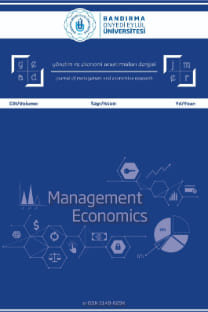Büyüme imkanı göstergelerinin firma büyümesi tahminindeki başarısı: Bıst örneği
The success of growth opportunities measures in the prediction of firm growth: The case of bist
___
- Adam, T. ve Goyal, V.K. (2008) The Investment Opportunity Set and Its Proxy Variables, Journal of Financial Research, 31(1): 41 - 63.
- Barclay M.J. ve Smith C.W. (1995) The Maturity Structure of Corporate Debt, The Journal of Finance, 50(2): 609- 632.
- Ben- Horim, M. ve Callen, J.L. (1989) The Cost of Capital, Macaulay's Duration, and Tobin's Q, Journal of Financial Research, 12(2): 143 -156.
- Campbell, J.Y., Hilscher, J. ve Szilagyi, J. (2008) In Search of Distress Risk, The Jo urnal of Finance, 63(3): 2899- 2939.
- Carpenter, R.E. ve Guariglia, A. (2008) Cash Flow, Investment, and Investment Opportunities: New Tests Using UK Panel Data, Journal of Banking and Finance, 32(9): 1894- 1906.
- Chan, K., Karceski, J. ve Lakonishok, J. (20 03) The Level and Persistence of Growth Rates, Journal of Finance, 58(2): 634- 684.
- Chung, K.H. ve Charoenwong, C. (1991) Investment Options, Assets in Place, and the Risk of Stocks, Financial Management, 20(3): 21 - 33.
- Cleary, S. (1999) The Relationship between Firm Investment and Financial Status, The Journal of Finance, 54(2): 673- 692.
- Danbolt, J., Hirst, I.R.C. ve Jones, E. (2011) The Growth Companies Puzzle: Can Growth Opportunities Measures Predict Firm Growth?, The European Journal of Finance, 17(1): 1 - 25.
- Fazzari, S.M., Hubbard, R.G. ve Petersen, B.C. (1988) Financing Constraints and Corporate Investment, Brookings Papers on Economic Activity, 1988(1): 141 - 195.
- Fama, E.F. ve French, K.R. (1995) Size and Book-to- Market Factors in Earnings and Returns, The Journal of Finance, 50(1): 131 -155.
- Farinas, J.C. ve Moreno, L. (2000) Firms Growth, Size and Age: A Nonparametric Approach, Review of Industrial Organization, 17(3): 249- 265.
- Goyal, V.K., Lehn, K. ve Racic, S. (2002) Growth Opportunities and Corporate Debt Policy: The Case of the U.S. Defense Industry, Journal of Financial Economics, 64(1): 35- 59.
- Hosono, K. (2003) Growth Opportunities, Collateral and Debt Structure: The Case of the Japanese Machine Manufacturing Firms , Japan and the World Economy, 15(3): 275- 297.
- Jo, H., Pinkerton, J.M. ve Sarin, A. (1994) Financing Decisions and the Investment Opportunity Set: Some Evidence from Japan, Pacific- Basin Finance Journal, 2(2- 3): 227- 242.
- Kallapur, S., ve Trombley, M.A. (1999) The Association between Investment Opportunity Set Proxies and Realized Growth, Journal of Business Finance and Accounting, 26(3 - 4): 505-519 .
- Kaplan, S.N. ve Zingales, L. (1997) Do Investment- Cash Flow Sensitivities Provide Useful Measures of Financing Constraints?, The Quarterly Journal of Economics, 112(1): 169 -215.
- Kim, E.H. ve Purnanandam, A. (2013) Seasoned Equity Offerings, Corporate Governance, and Investments, Review of Finance. doi: 10.1093/rof/rft012
- Kogan, L. ve Papanikolaou, D. (2013) Firm Characteristics and Stock Returns: The Role of Investment- Specific Shocks, Review of Financial Studies, doi: 10.1093/rfs/hht026
- Laeven, L. ve Valencia, F. (2013) The Real Effects of Financial Sector Interventions during Crises, Journal of Money, Credit and Banking, 45(1): 147 -177.
- Lang, L., Ofek, E. ve Stulz, R.M. (1996) Leverage, Investment and Firm Growth," Journal of Financial Economics, 40(1): 3- 29.
- Lyandres, E. ve Zhdanov, A. (2013) Investment Opportunities and Bankruptcy Prediction, Journal of Financial Markets, 16(3): 439 -476.
- McConnell J.J. ve Servaes, H. (1995) Equity Ownership and the Two Faces of Debt, Journal of Financial Economics, 39(1): 131 - 157.
- Miller, M.H. ve Modigliani, F. (1961) Dividend Policy, Growth and the Valuation of Shares, Journal of Business, 34(4): 411 -433.
- Myers, S.C. (1977). Determinants of Corporate Borrowing, Journal of Financial Economics, 5(2): 147 -175.
- Rajan, R.G. ve Zingales, L. (1995) What Do We Know about Capital Structure? Some Evidence from International Data, The Journal of Finance, 50(5): 1421 - 1460.
- Smith, C.W. ve Watts, R.L. (1992) The Investment Opportunity Set and Corporate Financing, Dividend, and Compensation Policies, Journal of Financial Economics, 32(3): 263- 292.
- Yermack, D. (1996) Higher Market Valuation of Companies with a Small Board of Directors, Journal of Financial Economics, 40(2): 185 -211.
- ISSN: 2148-029X
- Yayın Aralığı: 4
- Başlangıç: 2013
- Yayıncı: Bandırma Onyedi Eylül Üniversitesi İ.İ.B.F.
Arap baharı'nın Türkiye ekonomisine etkileri1
Özge ŞAHİN UYSAL, Mehmet ŞAHİN
Adli muhasebede uzman tanıklık mesleği: Muhasebe meslek mensupları üzerine bir araştırma1
Fikret ÇANKAYA, Engin DİNÇ, Yurdagül ÇOBAN
Ramazan Eyüp GERGİN, Birdoğan BAKİ, İlker Murat AR
Cebrail MEYDAN, Sebahattin YILDIZ
Küresel kriz sonrası uluslararası para birimi olarak euro ve geleceği
Umut EVLİMOĞLU, Yasemin BOZDAĞLIOĞLU
İş ortamında şiddet, tükenmiilik ve iş tatmini ilişkileri:Sağlık çalışanları üzerinde bir araştırma
Bulanık hedef program lama ile menü planlama
Türkiye ve başlıca ab pay piyasaları arasında asimetrik volatilite yayılımı 1
İbrahim Yaşar GÖK, Hakan DEMİRGİL
Karar verme stratejilerinin öğrencilerin iiletme seçimi üzerindeki etkisi
